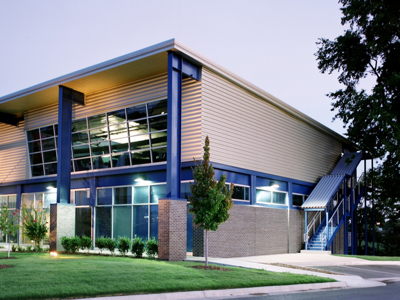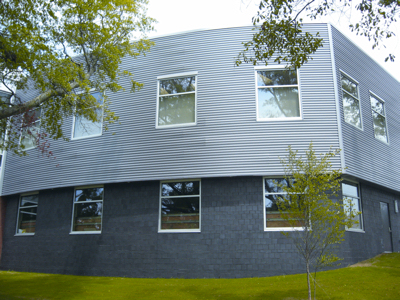Metal Wall Panels: An Industry Perspective – Part II
By Marge O'Connor, DesignandBuildwithMetal.com
Editor's Note: Targeting Decision Makers is the second installment of a three-part article based on extensive interviews with industry executives representing the makers of single-element metal wall panel systems, insulated metal wall panel systems and metal composite material wall panel systems. Part I, titled Metal Wall Panels – Going From Simple To Spectacular, can be read by clicking here. Part III, titled What's Ahead For Metal Wall Panels, can be read by clicking here.
Targeting Decision Makers
The changing perception of metal panels among decision makers has also been influenced by manufacturers’ promotional efforts. These include educating decision makers about metal and delivering messages through the standard methods of advertising,
public relations, trade shows, sales calls, lunch-and-learn sessions, and more recently extending it to a wider scope of electronic media.
 |
The Benham Office Building in Lowell, AR, shows how standard ribbed wall panels from MBCI are
being used to create interesting architectural patterns, and complement other metal components and building materials. Click image to enlarge. | |
“Manufacturers in our industry are all astute marketers and have been doing a great job for a long time. But electronic communication now is a very important part of the mix and will continue to be. Five years ago it was less than 15 percent of
our marketing program; today it’s substantially more,” notes Doug Pickens, vice president of marketing for Metl-Span LLC, Lewisville, TX.
He also noted several reasons why electronic marketing is growing. “Electronic marketing is faster and typically generates a better return than direct mail, where a 1.5 percent response rate is normal and 6 percent is high. Email open rates are
about 25 to 30 for architects and contractors. Targeted emails to an existing customer base can have an open rate as high as 40 percent.”

| 
|  |
Brandon Wyatt | Doug Pickens | Jim Bush |
Brandon Wyatt, Marketing Manager, 3A Composites USA (formerly Alcan Composites USA, Inc.), Charlotte, NC, agrees. He said the new paths being taken to reach decision makers are based in large part on the different methods now available. “The
libraries in architectural firms are smaller because specs and design applications are now being data-based and accessed online. The hard cover binders and literature are becoming more scarce as they can go online or pick up a CD or memory stick at
a trade show with all the information in downloadable format. One click away is a lot closer than a walk to the archive.”
 |
The Warren County Technology Center in Bowling Green, KY, features a variety of curved and flat wall panels from CENTRIA,
meld with the brick on the lower exterior. The Duracast finish on the metal panels look like precast but provides the long service like of metal.Click image to enlarge. | |

The Tempe Transportation Center in Tempe, AZ, features Alucobond panels with a Spectra Green finish that features iridescent highlights. The transitional coating is one of the latest trends in coating
technology and offers ever-changing color gradation of the metal panels. Click image to enlarge.
| |
In addition to communication vehicles, changes in the education needs of decision makers have also occurred. “The AIA’s increased learning requirements have been a good thing. Metal sustainability, for example, is not, specifically taught
in all schools and neither is any kind of performance technology for walls and roofs. So manufacturers have been helping to fill that gap with continuing education programs,” says Rick Brow, director of marketing for CENTRIA, Moon Township,
PA.
Sometimes, delivering the right message to decision makers requires a mix of old and new tools. For example, if a building owner or contractor does not use the Internet regularly, manufacturers still have to reach them through print magazines or direct
mail.
Keeping all options open is important, says Julie Pawuk, Marketing Communications Manager, for CENTRIA. “Many seem to be focused on online communication, but that’s only part of the way to get your message across. Direct mail, trade shows,
sponsorships, samples, and literature are still required. It’s a total process of which electronic is only one part.”
No matter the method, educating the building owners and contractors is still a key process, notes Wyatt. “Although the majority of decision-making power rests with the architect, they may be influenced in final product selection by building
owners or contractors when the market becomes more cost based as it is in this economy. This has architects researching products when a contractor wants to do a substitution. Or a general contractor may have experience with certain products and encourages
the architect to switch out.”

|  |  |  |  |
Julie Pawuk | | Ken Buchinger | | Rick Brow |
Architects role in the process has had its own evolution, according to Brow. “About 20 years ago, decision-making changed when the emphasis shifted to using contractors’ project managers to oversee the actual construction part of a project.
At that point, architects began to focus solely on design. Today architects have moved back into total performance and the science of how to build walls and roofs to meet performance. They also have formed building envelope councils, which are local
or regional groups that meet about once a month to discuss how to create better performing buildings.” (Note: The Building Enclosure Council’s Web site is www.bec-national.org)
To get the right message to the right decision makers, manufacturers need to understand the special needs of each group. “Owners rely on performance; architects also want performance but usually put more emphasis on aesthetics. General contractors
are ultimately responsible for performance but must follow the specs, so they look at price and liability, along with meeting project specifications. When we design products we consider how they will meet the top three decision factors – aesthetics,
performance and sustainability -- to make them attractive to a broader mass of decision makers,” adds Brow.
 |
Norton Brownsboro Hospital in northeastern Jefferson County, KY, offers a stunning example of how a blend of metal panels with other construction materials adds texture to a building's appearance. The insulated metal panels from Metl-Span, in bronze and oyster colors, also enhance the facility's energy
efficiency. The five-story, 298,000 sq. ft. hospital is the first new full-service hospital to open in the Louisville area in more than 20 years. Click image to enlarge. | |
 |
The Cape Fear Sports Medicine building in Wilmington, NC uses Rigid Wall panels in a silversmith color from ATAS International to
form a warm contrast against dark gray masonry. Click image to enlarge. | |
Jim Bush, vice president of sales for ATAS International, Allentown, PA notes the increased opportunities when contractors are involved. “Sometimes the process includes contractors who specialize in maintenance, and showing them how metal can be
used and how they can help building owners with this information. This opens up more opportunities for manufacturers because it goes beyond our traditional sales channels. Add to this the boom in electronic media. That makes our decisions on where
to put marketing dollars more challenging. We need to determine how to reach all of the decision makers and that varies by who they are.”
The message is also determined by what materials or products metal may be competing with in a given market.
“In wall cladding we compete with EIFS, masonry, precast, GFRC (glass fiber reinforced concrete) and glass curtainwall. If you compare some metal panel systems to each of these on price only, you’re forgetting the importance of the weight
of foundation and framing in certain situations. That changes the price when you look at the total cost of all of the related components. Long-term durability is another big plus for metal; with most precast, for example, you’ll eventually have
to repaint and reseal the exterior,” adds Brow.
Pickens agrees: “We may compete with other metal wall products, but brick, block, tilt-up and precast materials are our real competition. For IMPs, energy conservation is the best selling point against these materials because insulation has to be
added to each of them and they are composed of multiple components. Both of these factors add cost, particularly for installation/labor. What’s really driving the increase in market share for IMPs, however, is their ability to provide long-term
energy conservation. As the cost of energy to operate a building continues to soar, the market for IMPs will grow,” notes Pickens.
Staying ahead of the competition is just one of the challenges going forward. In the third part of our series, “What’s Ahead for Metal Wall Panels,” we look at the different opportunities and expectations for the market as a whole and
for various panel types.
Editor's Note: Our third installment, “What's Ahead For Metal Wall Panels,” discusses trends and issues driving the metal wall panel industry. To read it, click here.
For hotlinks to the websites of the companies mentioned in this article, as well as dozens of other leading manufacturers of metal wall panel systems, please visit the Metal Wall Panels section of our Manufacturers & Suppliers Directory here. By using the directory's category search feature you can see makers broken out according to 13 different metal wall segments.